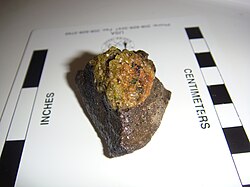Iddingsite
| Igneous rock | |

Olivine weathering to iddingsite
|
|
| Composition | |
|---|---|
| Olivine, clays, ferrihydrites |
| Iddingsite | |
|---|---|

Photomicrograph of iddingsite
|
|
| General | |
| Category | Silicate mineral (not a proper mineral) |
|
Formula (repeating unit) |
MgFe2Si3O10•4(H2O) |
| Crystal system | Orthorhombic |
| Identification | |
| Color | Brown |
| Crystal habit | Foliated |
| Cleavage | Perfect |
| Mohs scale hardness | 3 |
| Luster | Vitreous |
| Streak | None |
| Diaphaneity | Transparent to translucent |
| Specific gravity | 2.5 - 2.8 |
| Optical properties | Biaxial (-) |
| References | |
Iddingsite is a microcrystalline rock that is derived from alteration of olivine. It is usually studied as a mineral, and consists of a mixture of remnant olivine, clay minerals, iron oxides and ferrihydrites. Debates over iddingsite's non-definite crystal structure caused it to be de-listed as an official mineral by the IMA; thus it is properly referred to as a rock.
Iddingsite forms from the weathering of basalt in the presence of liquid water and can be described as a phenocryst, i.e. it has megascopically visible crystals in a fine-grained groundmass of a porphyritic rock. It is a pseudomorph that has a composition that is constantly transforming from the original olivine that pass though many stages of structural and chemical change to create a fully altered iddingsite.
Because iddingsite is constantly transforming it does not have a definite structure or a definite chemical composition. The chemical formula for iddingsite has been approximated as MgO * Fe2O3 * 4 H2O where MgO can be substituted by CaO. The geologic occurrence of iddingsite is limited to extrusive or subvolcanic rocks that are formed by injection of magma near the surface. It is absent from deep-seated rocks and is found on meteorites. As it has been found on Martian meteorites, its ages have been calculated to obtain absolute ages when liquid water was at or near the surface of Mars.
Iddingsite is a pseudomorph, and during the alteration process the olivine crystals had their internal structure or chemical composition changed, although the external form has been preserved. This is not true for all phases of the alteration of olivine because the atomic arrangement becomes distorted and causes a non-definite structure to form. Iddingsite has a composition that is constantly transforming from the original olivine passing though many stages of structural and chemical change.
Iddingsite has been a subject researched in recent years because of its presence in the Martian meteorites. The formation of iddingsite requires liquid water, giving scientists an estimate as to when there has been liquid water on Mars. Potassium-argon dating of the meteorite samples showed that Mars had water on its surface anywhere from 1300 Ma to 650 Ma ago.
...
Wikipedia
